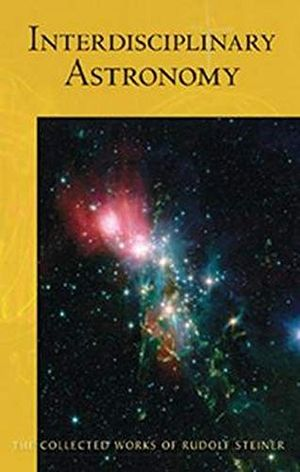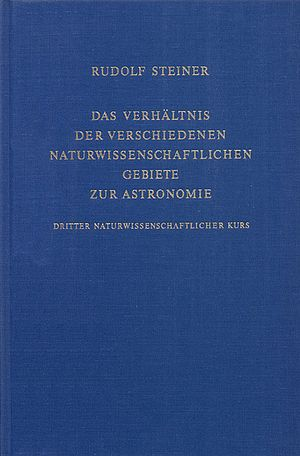GA 323: Difference between revisions
No edit summary |
No edit summary |
||
| Line 6: | Line 6: | ||
Eighteen lectures in Stuttgart from 1 to 18 January 1921. | Eighteen lectures in Stuttgart from 1 to 18 January 1921. | ||
What is the relationship between the human being and the world of the stars? Can we comprehend the structure and movement of celestial bodies solely through advanced mathematics, or is there in reality a point beyond which mathematical functions no longer apply? Can we, in fact, transcend the limits of three-dimensional space through our thinking? | |||
In eighteen lively lectures from the beginning of 1921, Rudolf Steiner dives deeply and courageously, though carefully, into these and other profound questions. His conclusions and indications for further research are at once fascinating, stimulating, and quite possibly revolutionary in their implications. | |||
The subject of these lectures is not astronomy, broadly considered, but the relationship of astronomy to the other fields of natural science. As he does elsewhere, Steiner maintains that the rigid specialization so prevalent in scientific endeavors will not bring us any closer to an integrated, singularly comprehensible understanding of the reality of our world. In particular, a true grasp of the workings of the universe will not be possible until its mirror, the study of human embryology, is recognized as such and penetrated with this reflective relationship in mind. | |||
Steiner once again shows himself to be both an utterly unique and masterful commentator on scientific and intellectual history, as well as a living light, shining a possible forward path for human progress and self-knowledge. | |||
=== Contents === | === Contents === | ||
Latest revision as of 07:15, 12 September 2021


The Relationship of the Various Natural Science Fields to Astronomy
Third Natural Science Course: Celestial Science in Relation to Man and the Study of Man.
Eighteen lectures in Stuttgart from 1 to 18 January 1921.
What is the relationship between the human being and the world of the stars? Can we comprehend the structure and movement of celestial bodies solely through advanced mathematics, or is there in reality a point beyond which mathematical functions no longer apply? Can we, in fact, transcend the limits of three-dimensional space through our thinking?
In eighteen lively lectures from the beginning of 1921, Rudolf Steiner dives deeply and courageously, though carefully, into these and other profound questions. His conclusions and indications for further research are at once fascinating, stimulating, and quite possibly revolutionary in their implications.
The subject of these lectures is not astronomy, broadly considered, but the relationship of astronomy to the other fields of natural science. As he does elsewhere, Steiner maintains that the rigid specialization so prevalent in scientific endeavors will not bring us any closer to an integrated, singularly comprehensible understanding of the reality of our world. In particular, a true grasp of the workings of the universe will not be possible until its mirror, the study of human embryology, is recognized as such and penetrated with this reflective relationship in mind.
Steiner once again shows himself to be both an utterly unique and masterful commentator on scientific and intellectual history, as well as a living light, shining a possible forward path for human progress and self-knowledge.
Contents
This course builds a bridge from man and the natural kingdoms surrounding him to the workings of the cosmos. A wealth of facts from geology, botany, comparative anatomy, physiology, psychology, mathematics and astronomy are looked at together from a comprehensive point of view. Older views of celestial phenomena are appreciated as appropriate expressions of other levels of consciousness.
Literature
- Rudolf Steiner, Frederick Amrine (Translator), David Booth (Introduction): Interdisciplinary Astronomy: Third Scientific Course. CW 323. SteinerBooks 2020. ISBN 978-1621480709 rsarchive.org
German
- Rudolf Steiner: Das Verhältnis der verschiedenen naturwissenschaftlichen Gebiete zur Astronomie, GA 323 (1997), ISBN 3-7274-3230-6 English: rsarchive.org German: pdf pdf(2) html mobi epub archive.org
 |
References to the work of Rudolf Steiner follow Rudolf Steiner's Collected Works (CW or GA), Rudolf Steiner Verlag, Dornach/Switzerland, unless otherwise stated.
Email: verlag@steinerverlag.com URL: www.steinerverlag.com. Index to the Complete Works of Rudolf Steiner - Aelzina Books A complete list by Volume Number and a full list of known English translations you may also find at Rudolf Steiner's Collected Works Rudolf Steiner Archive - The largest online collection of Rudolf Steiner's books, lectures and articles in English. Rudolf Steiner Audio - Recorded and Read by Dale Brunsvold steinerbooks.org - Anthroposophic Press Inc. (USA) Rudolf Steiner Handbook - Christian Karl's proven standard work for orientation in Rudolf Steiner's Collected Works for free download as PDF. |
